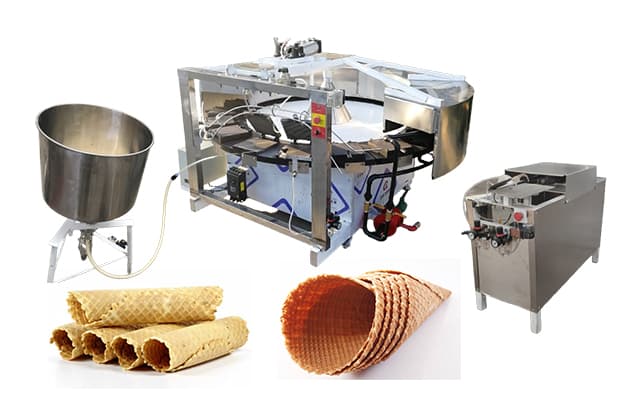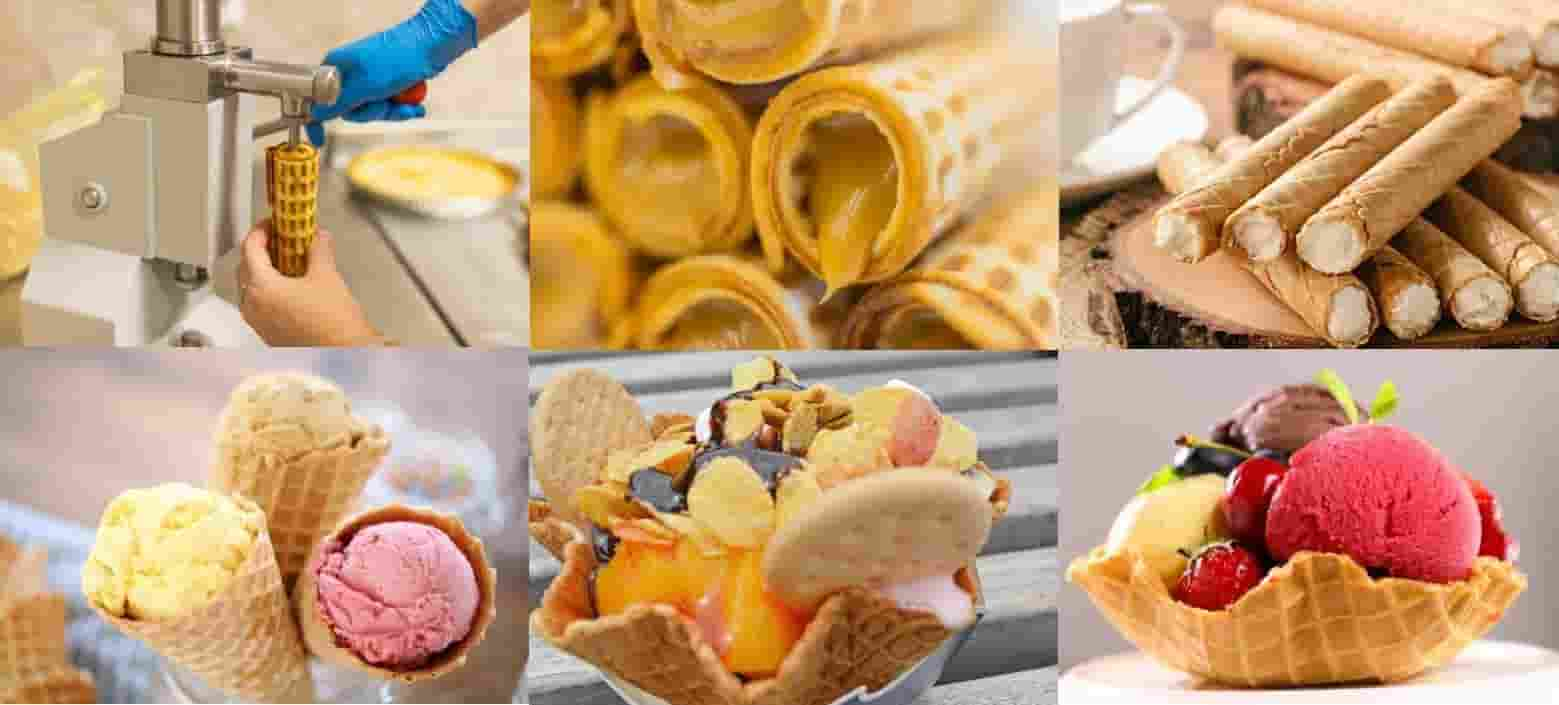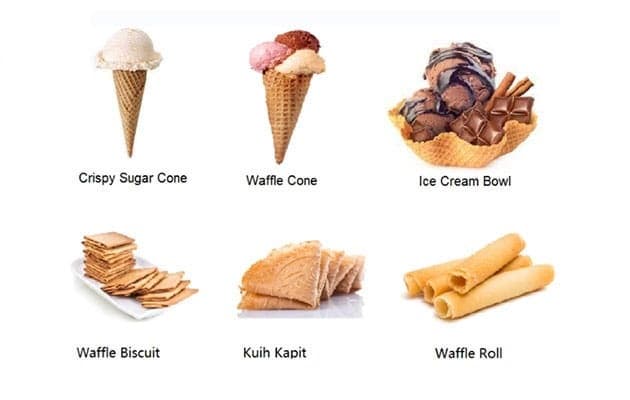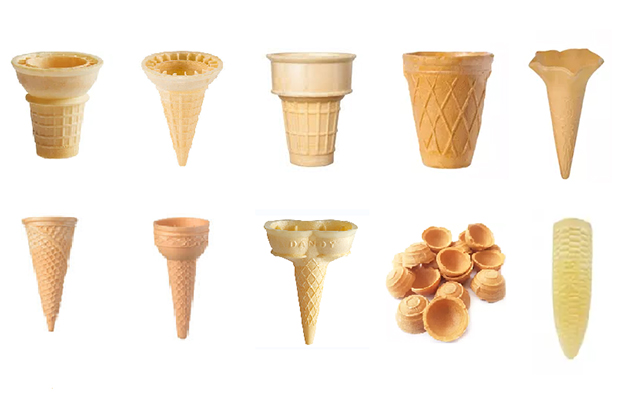La texture d'un cornet de glace est l'un des facteurs les plus importants déterminant la qualité du produit et la satisfaction du client.. Certains consommateurs préfèrent cornets de gaufres croustillants avec un croquant satisfaisant, tandis que d'autres apprécient cônes plus doux et plus flexibles qui ne s'effondre pas facilement.
Pour les fabricants utilisant machines automatiques à cornets de glace, ajuster le formule et processus de cuisson correctement peut faire toute la différence. Cet article expliquera comment modifier les ingrédients, température, et les niveaux d'humidité pour produire des cornets plus croustillants ou plus mous, vous aidant à perfectionner votre recette et à améliorer l'efficacité de la production..

1. Comprendre la science de la texture des cornets de crème glacée
La texture d'un cornet de glace dépend principalement de teneur en humidité, niveau de sucre, composition en matières grasses, et conditions de cuisson.
Quand les cornets sont cuits, l'eau s'évapore et le sucre caramélise, créer une structure qui détermine si le cône devient léger et croustillant ou tendre et moelleux. Même de petits changements dans la formule peuvent modifier cet équilibre de manière significative.
| Facteur | Effet sur la texture | Résultat |
|---|---|---|
| Faible humidité + température de cuisson élevée | Sec et croquant | Cône croquant |
| Humidité élevée + température de cuisson plus basse | Conserve la flexibilité | Cône souple |
| Teneur élevée en sucre | Caramélisation et croustillant | Plus croustillant |
| Teneur élevée en matières grasses | Tendresse et douceur | Cône plus doux |
Comprendre ces relations aide les fabricants à affiner leur formule de cône en fonction des préférences des clients et de la demande du marché..
2. Formule de base pour cornet de crème glacée
Voici une formule de base standard utilisée dans les lignes de production commerciale:
| Ingrédient | Pourcentage (%) | Fonction |
|---|---|---|
| Farine de blé | 45–50 | Fournit une structure |
| Sucre | 20–25 | Douceur, caramélisation |
| Eau | 20–25 | Hydratation, vapeur |
| Huile ou beurre | 3–5 | Tendresse, saveur |
| Œufs (facultatif) | 2–3 | Couleur et structure |
| Sel | 0.2–0,3 | Équilibre la saveur |
| Émulsifiant (facultatif) | 0.5 | Améliore la texture |
| Bicarbonate de soude (facultatif) | 0.2 | Ajoute de la légèreté |
Cette formule produit un cône équilibré c'est croustillant mais pas trop cassant. De ce point de départ, vous pouvez ajuster les ratios pour obtenir le niveau de croustillant ou de moelleux souhaité.

3. Comment faire des cornets de crème glacée plus croustillants
UN cornet croustillant se caractérise par une faible humidité, poids léger, et une bouchée croustillante. Pour rendre les cornets plus croustillants, se concentrer sur la réduction de l’humidité et l’augmentation de la caramélisation du sucre.
3.1. Réduire la teneur en eau
Réduire la teneur en eau de 5 à 10 % permet de créer une pâte plus sèche. Moins d'eau signifie moins de vapeur pendant la cuisson, ce qui donne une texture plus croustillante.
3.2. Augmenter le sucre ou le sirop
Le sucre favorise la caramélisation et la texture cassante. Augmenter le sucre de 2 à 5 % améliore le croustillant mais doit être équilibré pour éviter un brunissement excessif.
🔸 Astuce: Utilisez du sucre blanc fin ou du sirop de glucose pour un meilleur contrôle de la couleur et du croustillant..
3.3. Augmenter la température de cuisson
Augmentez la température de cuisson de 10–15 ° C tout en raccourcissant légèrement le temps de cuisson. Cela garantit que le cône sèche rapidement et devient ferme..
Gamme de pâtisserie typique:
- 180–200°C pour des cornets croustillants
- 160–175°C pour cônes souples
3.4. Réduire l'huile ou la graisse
Le gras contribue à la douceur. Réduire la teneur en huile de 1 à 2 % peut rendre la structure du cône plus dure et plus croustillante..
3.5. Ajouter la fécule de maïs ou la farine de riz
Ajouter 5 à 10 % de fécule de maïs (remplacer une partie de la farine de blé) améliore le croustillant en réduisant la formation de gluten.
3.6. Assurer un refroidissement adéquat
Après la cuisson, les cônes doivent être refroidis rapidement à l’air sec. L'humidité pendant le refroidissement peut ramollir les cônes. Utilisez un convoyeur de refroidissement ou déshumidificateur pour conserver le croustillant.

4. Comment faire des cornets de crème glacée plus doux
Pour les cônes qui restent souple et doux, particulièrement utile pour emballer ou remplir des cônes, la formule et le processus de cuisson doivent retenir plus d'humidité et de graisse.
4.1. Augmenter l'eau ou le lait
Ajoutez 5 à 10 % de liquide en plus (eau ou lait) pour augmenter l'hydratation de la pâte. Cela ralentit l'évaporation de l'humidité pendant la cuisson.
4.2. Ajouter plus d'huile ou de beurre
L'augmentation de la teneur en matières grasses de 1 à 2 % adoucit la structure et donne une sensation en bouche plus douce..
4.3. Réduire la température de cuisson
Baissez la température de cuisson à environ 160–170°C tout en augmentant légèrement le temps de cuisson. Cela évite un séchage excessif.
4.4. Ajouter l'œuf ou la lécithine
Les œufs et les émulsifiants améliorent l'élasticité et préviennent la fragilité. Ajoutez 1 à 2 % de liquide d'œuf ou de lécithine à la formule.
4.5. Contrôler le refroidissement et le stockage
Pour des cônes plus mous, éviter un refroidissement excessif. Conservez-les dans un environnement à humidité contrôlée (45–55% HR) pour éviter une sécheresse excessive.
5. Effet des ingrédients sur la texture
| Ingrédient | Fonction | Ajustement pour le croustillant | Ajustement pour la douceur |
|---|---|---|---|
| Eau | Contrôle l'humidité | Diminuer | Augmenter |
| Sucre | Ajoute de la douceur & croustillant | Augmenter | Diminuer légèrement |
| Huile/Beurre | Ajoute de la richesse & douceur | Diminuer | Augmenter |
| Farine | Fournit une structure | Utilisez moins de farine de gluten | Utilisez de la farine ordinaire |
| Maïzena | Réduit le gluten, ajoute du croquant | Ajouter 5 à 10 % | Réduire ou omettre |
| Lait/Oeuf | Ajoute de l'élasticité | Limité à 1-2 % | Augmente légèrement |
| Temps de cuisson | Affecte le séchage | Court & chaud | Long & faible |
| Refroidissement | Affecte la rétention d’humidité | Refroidissement rapide | Refroidissement contrôlé |
En ajustant systématiquement ces variables, vous pouvez adapter la texture du cône à n'importe quelle exigence du marché, que ce soit pour cornets de gaufres durs, cônes roulés, ou cônes souples en forme de plaquette.

6. Facteurs environnementaux affectant la texture du cône
Même avec la même formule, l'environnement peut influencer le produit final:
6.1. Humidité
Les cônes absorbent facilement l'humidité de l'air. Conserver les zones de production et de stockage en dessous 50% humidité relative.
6.2. Température de stockage
Température de stockage idéale: 20–25°C. La chaleur extrême ramollit les cônes, tandis que le froid les rend cassants.
6.3. Conditionnement
Utiliser film laminé résistant à l'humidité pour préserver le croustillant et éviter le ramollissement pendant le transport.
6.4. Circuit de refroidissement
Un convoyeur de refroidissement automatique attaché à votre ligne de production de cônes aide à stabiliser la texture avant l'emballage.
7. Paramètres de la machine à pâtisserie pour le contrôle de la texture
Moderne machines automatiques à cornets de glace permettre un contrôle précis des conditions de cuisson pour obtenir la texture souhaitée.
| Paramètre | Cône plus croustillant | Cône plus doux |
|---|---|---|
| Température | 180–200°C | 160–170°C |
| Temps de cuisson | 90–120 secondes | 130–160 secondes |
| Pression de plaque | Moyen-élevé | Faible-moyen |
| Débit d'air de refroidissement | Fort | Modéré |
| Temps de démoulage | Rapide | Léger retard |
💡 Conseil: Utilisez des systèmes contrôlés par PLC pour automatiser les ajustements de température et de synchronisation pour une qualité constante.

8. Tests de qualité pour les cônes
Après la production, tester régulièrement la texture du cône pour maintenir la cohérence:
- Test d'humidité – Humidité idéale pour des cornets croustillants: ci-dessous 3%
- Essai de dureté – Utiliser un analyseur de texture pour mesurer la force de rupture
- Uniformité des couleurs – Le brun doré indique une bonne caramélisation
- Goût et arôme – Aucune odeur de brûlé ou de farine crue
- Stabilité de stockage – Testez après 48 à 72 heures pour la conservation du croustillant
Un contrôle de qualité constant garantit que chaque lot répond aux normes de texture de votre marque.
9. Problèmes courants et solutions
| Problème | Cause possible | Solution |
|---|---|---|
| Cônes trop mous | Trop d'eau ou température de cuisson basse | Réduire le liquide, augmenter la température |
| Cônes trop durs | Faible en gras ou faible humidité | Ajoutez plus d'huile ou réduisez le temps de cuisson |
| Couleur inégale | Chauffage inégal | Vérifier les plaques chauffantes ou le thermostat |
| Les cônes se fissurent facilement | Faible élasticité ou cuisson excessive | Ajouter l'oeuf, réduire la température |
| Cônes collants | Sucre insuffisamment cuit ou en excès | Prolonger légèrement le temps de cuisson |
La surveillance de ces détails peut vous aider à atteindre une production stable et à réduire les déchets.

10. Pourquoi travailler avec DT Food Machine
DT Food Machine Co., Ltée. est un fabricant professionnel de lignes de production automatiques de cornets de glace, offrant des solutions complètes depuis le mélange de la pâte jusqu'à la cuisson et l'emballage.
Nos avantages:
- Sur 15 années d'expérience en équipement de fabrication de cônes
- Machines adaptées pour différentes formes de cônes (cône de sucre, cornet de gaufre, cône de plaquette, cône roulé)
- Construction en acier inoxydable pour l'hygiène et la durabilité
- Système de contrôle par API pour un ajustement précis de la formule et de la texture
- Conception économe en énergie avec un faible coût d'exploitation
- Exporté vers plus de 60 pays mondial
Que vous produisiez des cornets gaufrés croustillants ou des cornets gaufrés moelleux, DT Food Machine peut personnaliser la ligne de production adaptée à vos besoins.
11. Comment ajuster la formule pour des cornets plus croustillants ou plus mous ?
Le secret pour produire des cornets de glace parfaits réside dans la compréhension de l'équilibre délicat entre les ingrédients., humidité, et la pâtisserie. En ajustant votre formule, qu'il s'agisse de réduire l'eau pour le croustillant ou d'ajouter de la graisse pour le moelleux, vous pouvez contrôler la texture finale en fonction des différents marchés..
Avec l'aide de machines automatiques à cônes et la bonne connaissance de la formulation, vous pouvez produire systématiquement des cornets qui ravissent les clients et renforcent la réputation de votre marque.
Si vous cherchez à optimiser votre production de cônes ou à passer à une ligne entièrement automatique, Machine alimentaire DT est votre partenaire de confiance pour atteindre une qualité constante, efficacité, et la rentabilité.

